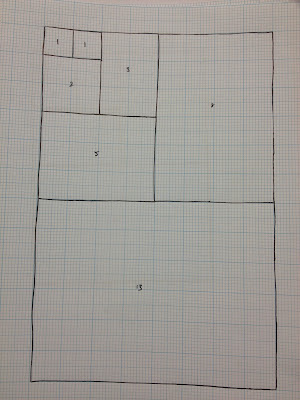The Fibonacci sequence is used to create ideally proportioned layouts for design. As a sequence it is derived from natural things, seen in things like flowers and sea shells. It is designed this way as an example of where the eye is directed around something and the idea is to lead it across a design.
The sequence is created by adding two previous numbers together:
1+1 = 2
1+2 = 3
2+3 = 5
3+5 = 8
5+8 = 13
8+13 = 21 ....
When replicating this sequence visually, two 1's are doubled to make a portion of 2, and from then the total of all the portions is replicated:
The Golden Ratio
The golden ratio is based around one number, 1.62, and it works simultaneously with Fibonacci sequence. With the development of design styles, grid structures like these have become more and more important, as have the sequences that make them.
Dividing the length of an area by 1.62 gives you the golden ratio:
Rule of Thirds
The rule of thirds is exactly how it sounds, when a design or grid is split into thirds to determine it's layout. This can also be seen in a lot of photography. It creates 9 boxes which can then each be divided further. In many photographs the subject matter and content will focus around these divisions.
We had each brought in a selection of magazines and used them to examine the grids and layouts used in the designs of the pages. We divided these pages up based on some of the rules we had just learnt:
By dividing up these pages we were able to identify how these layouts were structures, and in many cases the type fell into one of these thirds, that were sometimes determined by the image.
After realising how these pages were divided up we reconstructed them ourselves to find if there were other layouts that worked as well:










No comments:
Post a Comment